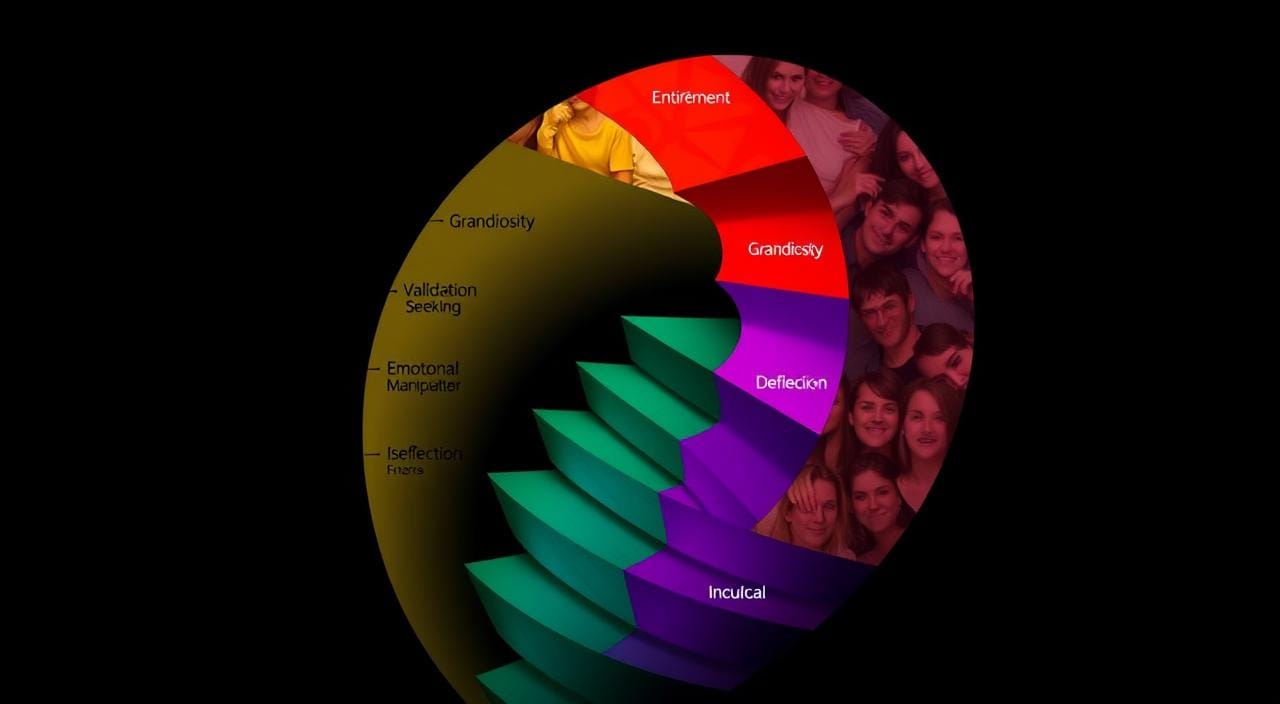Ever felt like you’re losing yourself in a relationship? Constantly changing to fit your partner’s needs? This is what narcissistic mirroring does. It’s a way for manipulative people to seem connected and accepted by their victims. Narcissistic mirroring means watching what you like and then showing it back to seem like you’re in sync. But it’s more than just mirroring; it’s a way to gain trust, find out what makes you vulnerable, and control you1. So what is reverse narcissistic mirroring?
If you’ve felt lost in a relationship like this, you’re not alone. People caught in narcissistic mirroring often find it hard to leave or doubt the toxic bond. But there’s a way out. Learning about narcissistic abuse and using reverse mirroring can help you take back your true self.
Key Takeaways
- Narcissistic mirroring is a manipulative tactic used to create a false sense of connection and belonging with victims.
- Intentional mirroring goes beyond passive reflection and is a strategic approach to build trust, gather information, emotionally manipulate, and create dependence.
- Victims of narcissistic mirroring may struggle to leave or question toxic relationships due to the emotional bond and sense of exclusivity.
- Understanding the cycle of narcissistic abuse and embracing reverse mirroring can help break free from the narcissist’s grasp.
- Recognizing narcissistic mirroring patterns is crucial in identifying warning signs, setting boundaries, and making informed decisions.
Understanding the Narcissistic Abuse Cycle
The narcissistic abuse cycle is a harmful pattern that deeply affects victims. This cycle usually follows four stages: idealization, devaluation, discard, and hoovering. At each stage, the narcissist uses different tactics to control and exploit their victims.
Idealization Phase
In the idealization phase, the narcissist creates a false connection with their victim. They shower the victim with attention and charm, using love bombing and mirroring to seem close2. Narcissists also project a positive image to boost their self-esteem3.
Devaluation Phase
The devaluation phase is very distressing for the victim. The narcissist lowers the victim’s self-esteem by criticizing and belittling them2. They use insults and gaslighting to make the victim doubt themselves2.
Discard Phase
In the discard phase, the narcissist suddenly stops caring about the victim. The victim feels confused and abandoned2. The narcissist may use the silent treatment for days or months2.
Hoover Phase
The hoover phase is when the narcissist tries to get the victim back. They may promise to change or threaten the victim to get them back2. This phase uses intermittent reinforcement to keep the victim trapped4.
“The narcissistic abuse cycle can be emotionally devastating, leading to feelings of depression, anxiety, and confusion for the victim. Recognizing and understanding this pattern of behavior is crucial to protecting one’s mental health and avoiding falling into a narcissistic relationship pattern.”
The Role of Mirroring in Narcissistic Abuse
Mirroring is a key part of narcissistic abuse. Narcissists mimic their victims’ words, actions, and body language to seem familiar and connected5. They reflect the victim’s best qualities, making them seem like the “perfect” partner or friend6.
The narcissist creates a false self that matches the victim’s ideal partner or friend6. They gather information about the victim’s desires to mirror them, building a strong emotional bond6.
But this mirroring is just a trick. Narcissists can’t truly connect with others because they lack emotional empathy6. They use mirroring to control and manipulate, keeping their victims dependent6.
| Mirroring Tactic | Purpose | Impact on Victim |
|---|---|---|
| Love-bombing | Rapidly create a sense of deep connection and intimacy | Victim feels swept off their feet, making them more susceptible to the narcissist’s influence5 |
| Mirroring positive and negative traits | Inhibit the victim’s self-reflection and personal growth | Victim struggles to identify their authentic self, becoming increasingly dependent on the narcissist’s validation5 |
| Scapegoating and blame shifting | Isolate the victim emotionally and prevent personal growth | Victim feels constantly at fault, undermining their self-confidence and self-worth5 |
| Controlling the victim’s social circle | Limit opportunities for the victim to develop outside the narcissist’s influence | Victim becomes increasingly dependent on the narcissist, cutting off avenues for personal growth and healing5 |
As the victim grows, mirroring becomes harder for the narcissist5. This can expose their manipulative ways, helping the victim see the truth5.

Understanding mirroring in narcissistic abuse is key for victims and supporters. Recognizing narcissistic tactics helps individuals heal and move forward67.
Reverse Narcissistic Mirroring: What It Is
Reverse narcissistic mirroring is a way to end narcissistic abuse8. It means showing the narcissist their own traits and actions. This makes them lose control and face their wrongdoings8. It helps the victim understand their healing and find their true self8.
Reflecting the Narcissist’s Traits Back at Them
Reflecting the narcissist’s traits is key in this method8. It’s hard because the victim must be aware and stand up to the narcissist8. By mirroring, the victim can upset the narcissist’s control and make them see their own wrong actions8.
Seeing Yourself in the Narcissist’s Behavior
Seeing yourself in the narcissist’s actions is also vital8. Recognizing how the narcissist mirrors your issues helps in healing8. This self-reflection is hard but necessary for breaking free and finding yourself again8.

“The narcissist acts as a mirror, reflecting the unhealed parts of ourselves that require attention.”
Reverse narcissistic mirroring is a strong tool against narcissistic abuse. Reflecting the narcissist’s traits and seeing yourself in them helps in healing and finding your identity89.
Childhood Trauma and Attachment Wounds
Our childhood experiences and early attachments deeply affect our risk of narcissistic abuse10. Growing up without validation and empathy can make our egos fragile10. This makes us more sensitive to criticism or threats10.
Divorce or separation can also hurt a child’s sense of security10. This makes them more likely to fall prey to a narcissist’s control10.
Also, not getting enough mirroring in childhood can lead to narcissism9. This can cause a child to lose touch with their true self9. They may then develop a false self and feel unworthy9.
People who didn’t get enough mirroring may seek validation outside themselves9. This makes them more open to a narcissist’s manipulation9.
When parents project their own trauma onto their children10, it can harm the kids’ self-image10. It can also make it hard for them to manage their emotions10.
Parents with deep emotional issues may have unrealistic expectations10. This can confuse a child’s understanding of love and responsibility10.
Healing from these early experiences is key to escaping narcissistic abuse9. Through therapy, people can rebuild their sense of self9. This helps them move beyond the narcissist’s influence9.
| Childhood Trauma | Impact on Narcissistic Abuse |
|---|---|
| Lack of validation and empathy from caregivers | Leads to fragile egos and sensitivity to criticism10 |
| Disruptions to child’s stability (e.g., divorce, separation) | Contributes to attachment wounds and vulnerability to manipulation10 |
| Parental projection of unresolved trauma or emotional issues | Can cause identity issues, low self-esteem, and emotional regulation difficulties in children10 |
| Inadequate mirroring in early childhood | A fundamental cause of narcissism, leading to a false self and lack of self-worth9 |
“Healing from parental projection involves rebuilding a child’s sense of identity and self-worth through therapy.”
By understanding how our childhood and attachment issues make us vulnerable to narcissistic abuse, we can start to heal109. This is the first step to breaking free from the cycle of harm109.
Reverse Narcissistic Mirroring and Sexuality
Reverse narcissistic mirroring can deeply affect a person’s sexuality and close relationships. The victim’s sexual identity and preferences might become distorted or hidden11. They are often drawn to the narcissist’s fake image, which reflects their own desires or ideal self11.
This attraction can lead to a codependent relationship, where the victim is stuck in a cycle of trauma bonding11.
The victim can start to reclaim their true sexuality and escape the narcissistic abuse. This involves dealing with childhood trauma and attachment issues that made them vulnerable11. With self-love and healing, they can take back control of their sexuality and build better relationships.

The narcissist uses tactics like reverse narcissistic mirroring to keep power over the victim12. They might manipulate the victim’s sexual identity and how they express it. By spotting these tactics and focusing on self-discovery, the victim can find their true self and end the abuse cycle12.
Healing and becoming empowered is key to overcoming the effects of reverse narcissistic mirroring. It’s a journey that needs patience, kindness to oneself, and a dedication to personal growth. But, the benefits of finding one’s true self are truly life-changing.
The Importance of Self-Love and Self-Awareness
Healing from narcissistic abuse starts with self-love and knowing yourself. Seeing your own worth, strengths, and qualities helps you escape the narcissist’s twisted view. This lets you find your real self13.
This journey means fighting off negative thoughts and patterns the narcissist created. It’s about embracing a stronger, more loving view of yourself.
Recognizing Your Own Strengths and Qualities
Healing means breaking free from the narcissist’s false world. It’s about shattering the fake image they made for you and finding your true self14. Setting boundaries and challenging their views helps you gain back your power.
Breaking Free from the Narcissist’s Illusion
The journey to self-love and awareness is tough but vital for those abused by narcissists. Self-love is about seeing your real self, not just how you look13. Focusing on self-care and acceptance helps you heal and regain your strength.

“True self-love is not about perfection; it’s about acceptance, vulnerability, and compassion.”
Recovering from narcissistic abuse means sticking to self-love and self-awareness14. By embracing who you truly are and escaping the narcissist’s trap, you can heal and find peace1314.
Reverse Narcissistic Mirroring: Breaking the Cycle
Using reverse narcissistic mirroring can help break the cycle of abuse. It reflects the narcissist’s actions back at them, disrupting their control. This requires us to be assertive and set clear boundaries15.
Reverse mirroring means showing the narcissist their own behaviors and feelings. It can be tough but helps us take back our freedom and identity15. It’s a way to stop being controlled and turn the tables.
By mirroring, we challenge the narcissist’s view of reality. This helps us stand up for ourselves and our needs. It’s key to breaking free from abuse15.
This approach isn’t easy. It can be emotionally tough and might lead to more abuse15. But, with the right support, it’s a powerful step towards healing.

Reverse narcissistic mirroring is about taking back our power. It’s standing up to the narcissist and refusing to be controlled15. By doing this, we start to heal and rebuild our lives.
Healing and Recovery After Narcissistic Abuse
Recovering from narcissistic abuse is a deep and complex journey. It’s about healing from the trauma and emotional pain caused by the abuser’s manipulation and gaslighting16. This healing needs self-compassion, patience, and facing the parts of ourselves that were twisted by the abuser16.
Addressing Trauma and Emotional Wounds
Healing starts with facing and healing the deep traumas and emotional wounds16. Getting help from therapists can help deal with the complex feelings and patterns from the abuse17. It’s also key to take care of ourselves, mind, body, and spirit, to find our true self16.
Rebuilding Self-Esteem and Confidence
Narcissistic abuse can really hurt our self-esteem and confidence17. The constant criticism and belittling can make us doubt our worth16. To regain our self-esteem, we must challenge the negative thoughts from the abuse and build a positive self-image16. This can be done through affirmations, achieving in our lives, and being around supportive people who see our true value16.
The path to healing from narcissistic abuse is tough but vital. By dealing with the trauma, rebuilding our self-worth, and focusing on self-care, we can overcome the abuse. We can regain our power and start a journey of growth and change17.
“Healing from narcissistic abuse involves facing uncomfortable truths and learning to love and protect one’s own traits that were idealized in the narcissist.”16
Conclusion
Exploring reverse narcissistic mirroring shows it can help end narcissistic abuse. Reflecting the narcissist’s actions back at them can upset their control. This makes them face their own wrongdoings18.
To use this method, we must become more self-aware and bold. We need to tackle the deep issues that made us vulnerable to abuse18. This path of self-love helps us find our true self and escape the narcissist’s grip19.
Using reverse mirroring is a key step towards healing from narcissistic abuse. Remember, you’re not alone on this hard journey. With the right help and support, you can heal and take back your life20.
FAQ
What is reverse narcissistic mirroring?
Reverse narcissistic mirroring is when you show the narcissist their own traits back at them. This can make them lose control and face their own manipulative ways.
How does the narcissistic abuse cycle work?
The cycle starts with idealization, where the narcissist showers you with love. Then, they devalue you, making you feel bad. Next, they discard you, and finally, they try to pull you back in with hoovering tactics.
What is the role of mirroring in narcissistic abuse?
Mirroring is a trick used by narcissists. They mimic your actions to seem close to you. This creates a false image of them as your ideal partner, trapping you further.
How can seeing oneself in the narcissist’s behavior help in the healing process?
Seeing the narcissist’s traits in yourself can be hard but helpful. It helps you understand your healing journey. This self-awareness is key to breaking free from abuse and finding your true self.
How does childhood trauma and attachment wounds contribute to narcissistic abuse?
Childhood trauma and attachment issues make you more open to narcissistic abuse. You might struggle to love yourself, making it easier for the narcissist to control you. Healing these wounds is crucial.
How can reverse narcissistic mirroring help in reclaiming one’s sexuality?
Reverse mirroring can help you reclaim your true sexuality. The narcissist might have distorted your sexual identity. Recognizing this can help you break free and find your authentic self.
What is the importance of self-love and self-awareness in healing from narcissistic abuse?
Self-love and self-awareness are essential for healing. They help you see your worth and strengths. This lets you challenge the negative views the narcissist has instilled in you.
How can reverse narcissistic mirroring help in breaking the cycle of narcissistic abuse?
Using reverse mirroring can be a powerful way to end the abuse cycle. It forces the narcissist to see their own actions. This requires you to stand up for yourself and set clear boundaries.
What are the key aspects of healing and recovery after narcissistic abuse?
Healing involves dealing with the trauma and rebuilding your self-esteem. It’s about finding support, practicing self-care, and becoming more confident. The journey is long but worth it for your freedom and well-being.
Source Links
- Narcissistic Mirroring Manipulation: The Narcissist Intentional Mirroring Technique That Leaves Victims Drowning – My Hidden Scars – https://myhiddenscars.com/mirroring-manipulation/
- The 4 Phases Of The Narcissist Abuse Cycle | Florida Women’s Law Group – https://www.floridawomenslawgroup.com/blog/the-4-phases-of-the-narcissist-abuse-cycle/
- Mirroring and Projection in the Cycle of Narcissistic Abuse – https://thelastchardonnay.com/2018/05/30/narcissistic-mirroring-and-projection/
- The Narcissistic abuse cycle: understanding how you became the victim – https://melaniemagowan.com/2024/01/23/the-narcissistic-abuse-cycle-understanding-how-you-became-the-victim/
- Why Narcissists Mirror Their Targets – https://medium.com/narc-alarms/why-narcissists-mirror-their-targets-8e812162266a
- Narcissist Mirroring: how they fool you into loving them – Vivian McGrath – https://www.vivianmcgrath.com/narcissist-mirroring/
- Reflecting on Vulnerable Narcissism – https://medium.com/@acfxsoldier/reflecting-on-vulnerable-narcissism-fd7217743ab2
- The Narcissist Is Your Mirror – https://blog.melanietoniaevans.com/the-narcissist-is-your-mirror/
- Narcissism and Inadequate Mirroring – Narcissistic Behavior – https://narcissisticbehavior.net/narcissism-and-inadequate-mirroring/
- The Empty Mirror: Narcissistic projection and the alienated child – https://karenwoodall.blog/2024/09/26/the-empty-mirror-narcissistic-projection-and-the-alienated-child/
- This is what you tell people who don’t believe you were abused by a narcissist – https://sylvialongmire.medium.com/a-guide-to-help-skeptical-friends-and-family-of-narcissistic-abuse-victims-understand-and-believe-9b4d14ac77f5
- 10 Ways Covert Narcissists Use Social Media to Control, Manipulate, and Punish You – https://sylvialongmire.medium.com/10-ways-covert-narcissists-use-social-media-to-control-manipulate-and-punish-you-828d8854ab87
- Is Self-Love Healthy or Narcissistic? – https://www.psychologytoday.com/us/blog/the-clarity/201702/is-self-love-healthy-or-narcissistic
- The Reflection of a Narcissist – https://medium.com/@jostiltscher/the-reflection-of-a-narcissist-2e3dabae6499
- How Narcissists Use DARVO to Avoid Accountability – https://www.verywellmind.com/protecting-yourself-from-darvo-abusive-behavior-7562730
- Heal by Seeing the Narcissist as Your Mirror – https://medium.com/@SPClusterB/heal-by-seeing-the-narcissist-as-your-mirror-fae5cd7cfb0d
- How I Found Incredible Love AFTER Narcissistic Abuse – https://www.revelationtherapy.com/single-post/how-i-found-incredible-love-after-narcissistic-abuse
- The anxious addictive narcissist: The relationship between grandiose and vulnerable narcissism, anxiety symptoms and Facebook Addiction – https://www.ncbi.nlm.nih.gov/pmc/articles/PMC7605684/
- Understanding and Treating Narcissism With EMDR Therapy – https://connect.springerpub.com/content/sgremdr/9/1/46
- CBT to Overcome Narcissistic Abuse: Understanding Echoism and Pseudo-Identity – https://bayareacbtcenter.com/cbt-to-overcome-narcissistic-abuse-understanding-echoism-and-pseudo-identity/







